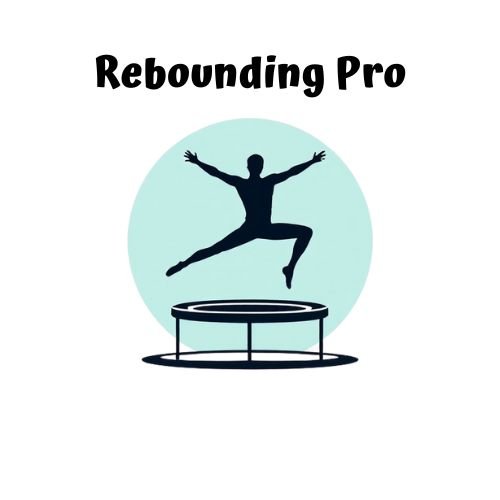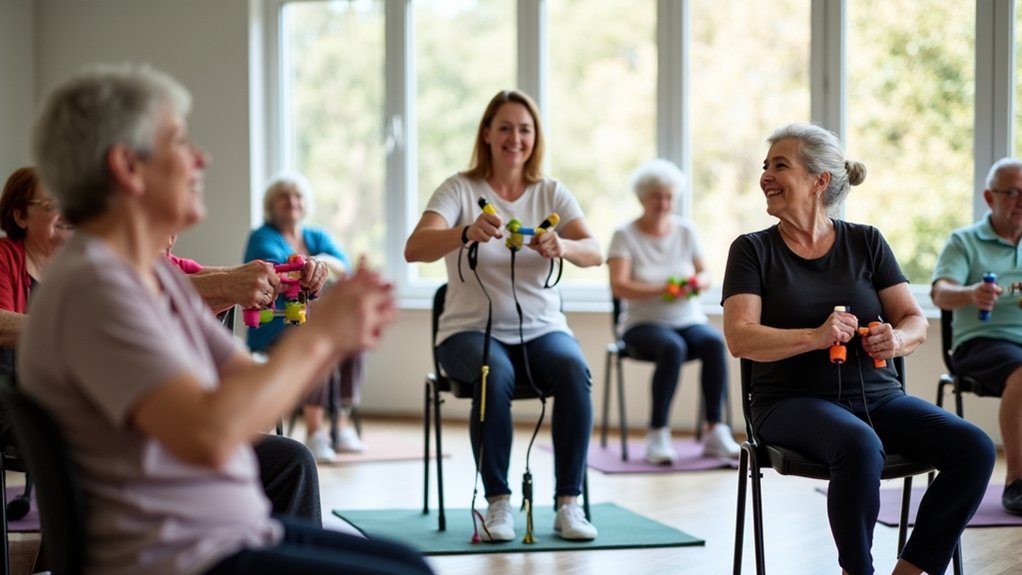Are you ready to make your rebounding workouts more comfortable? Compression shorts can transform your exercise experience by providing support, reducing muscle fatigue, and enhancing your overall performance. Whether you're on a mini-trampoline for fitness or recovering from an injury, the right compression wear makes all the difference. You'll want shorts that stay in place while offering the perfect balance of compression and flexibility. Let's explore three top options that combine function with comfort.
Bioflect Compression Shorts with Massaging Knit for Support and Comfort
If you're seeking effective relief from inflammation and muscle soreness while rebounding, Bioflect Compression Shorts stand out with their triple therapeutic approach. The bio-ceramic material, 3D micro-massage knitting, and moderate compression work together to stimulate capillaries and control fluid buildup.
You'll appreciate the full thigh coverage that eliminates visible bulges under clothing, while the breathable fabric delivers a massaging effect during your bounce sessions. Available in sizes S/M to 4XL, they're easy to care for—just machine wash on delicate and air-dry. Consider sizing up as they run small, ensuring you'll enjoy comfortable support during extended rebounding workouts.
Best For: People with lymphedema, inflammation, muscle soreness, or those seeking compression support during rebounding exercises who prefer a comfortable alternative to traditional compression stockings.
Pros:
- Combines three therapeutic methods (bio-ceramic material, micro-massage knitting, and moderate compression) to provide effective relief from inflammation and muscle soreness
- Full thigh coverage with high waist design eliminates visible bulges under clothing and prevents muffin top for most users
- Lightweight, breathable fabric delivers a massaging effect while being comfortable enough for extended wear
Cons:
- Sizing runs small, often requiring customers to order one size up for proper fit
- High waist may roll down for individuals with shorter waists or certain body types
- Some users report a mild initial odor that requires washing before first use
Under Armour Mens HeatGear Compression Shorts
Athletes seeking maximum support during high-impact rebounding activities will find Under Armour Men's HeatGear Compression Shorts an exceptional choice. The ultra-tight, second-skin fit delivers targeted muscle support while preventing uncomfortable bunching during intense bounce sessions.
You'll appreciate the strategic mesh panels that enhance ventilation when you're working up a sweat on the rebounder. The 6-inch inseam offers ideal coverage, while the ergonomic design minimizes abrasion during repetitive movements.
The Drop-in Strength Pocket™ provides convenient storage for small essentials during your workout. With an 84% Polyester and 16% Elastane blend, these shorts wick moisture away quickly, keeping you cool and comfortable.
Best For: Athletes and fitness enthusiasts seeking maximum support, moisture management, and comfort during high-impact activities like rebounding, running, or intense training sessions.
Pros:
- Ultra-tight, second-skin fit provides excellent muscle support while preventing bunching and riding up during movement
- Strategic mesh panels and HeatGear® fabric technology offer superior ventilation and quick-drying capabilities for comfort during intense workouts
- Versatile design with convenient Drop-in Strength Pocket™ makes these shorts suitable for various activities beyond just exercise
Cons:
- Sizing tends to run larger than expected, potentially requiring customers to order a size down for optimal fit
- No fly design may be inconvenient for some users looking for quick bathroom access
- Premium price point compared to standard athletic shorts, though justified by the technical features and durability
(3 Pairs) Mojo Compression Shorts for Women and Men 20-30mmHg – Opaque M819
When seeking maximum support during high-impact rebounding activities, the Mojo Compression Shorts deliver professional-grade 20-30mmHg compression that benefits both women and men.
These opaque M819 shorts blend 85% nylon with 15% spandex for a breathable, comfortable fit you'll appreciate during extended wear. They're specifically designed to improve blood flow, relieve varicose veins and edema, while stabilizing muscles during your rebounding workouts.
Users report noticeable benefits after just two weeks of use, with many highlighting reduced fatigue during and after exercise. You'll find them suitable for both daily wear and intense athletic activities, making them a versatile addition to your fitness wardrobe.
Best For: Athletes and individuals seeking professional-grade compression support for high-impact activities, circulation improvement, and muscle recovery.
Pros:
- Provides medical-grade 20-30mmHg compression for excellent blood flow improvement and muscle stabilization
- Breathable 85% nylon/15% spandex blend ensures comfort during extended wear periods
- Versatile design suitable for both daily use and intense athletic activities
Cons:
- Results may take up to two weeks before users notice significant benefits
- Higher compression level (20-30mmHg) might feel too tight for first-time compression wear users
- Limited information available about sizing options and fit adjustments for different body types
Factors to Consider When Choosing Compression Shorts for Rebounding Comfort
When selecting compression shorts for rebounding workouts, you'll need to evaluate several key factors that impact your exercise experience. Consider the compression level that suits your needs, breathable materials that manage sweat, strategic support zones, quality seam construction to prevent chafing, and appropriate length for coverage during high-intensity movements. These elements work together to enhance your comfort and performance while reducing muscle fatigue during rebounding sessions.
Compression Level Matters
Although many people overlook this essential detail, the compression level of your shorts greatly impacts your rebounding comfort and performance. Measured in mmHg (millimeters of mercury), these levels typically range from mild (15-20 mmHg) to firm (20-30 mmHg).
When you're bouncing on a rebounder, the right compression level provides critical muscle stabilization that can prevent injuries and reduce fatigue. For intense rebounding sessions, consider shorts with 20-30 mmHg, which enhance blood circulation and offer superior support. This higher level is particularly beneficial if you're dealing with varicose veins or edema.
However, don't automatically opt for maximum compression. Match the level to your specific needs and activity intensity. Too much compression can cause discomfort, while too little won't deliver the support your muscles need during rebounding exercises.
Material Breathability
Because your body generates significant heat during rebounding exercises, the breathability of your compression shorts becomes vital for maintaining comfort. Look for nylon-spandex blends that allow proper air circulation while managing moisture effectively during your bouncing sessions.
Quality compression shorts incorporate moisture-wicking technology that pulls sweat away from your skin, preventing the chafing and discomfort that can cut your workout short. This feature becomes essential during high-intensity rebounding intervals when perspiration increases.
Strategic mesh panels provide targeted ventilation in high-sweat areas, enhancing the overall breathability of your shorts. These thoughtful design elements help regulate your body temperature throughout extended rebounding sessions.
Support Zone Placement
Strategic support zone placement within compression shorts dramatically impacts your rebounding experience. Look for designs with graduated compression that applies stronger pressure at the ankle, gradually decreasing toward the thigh. This smart pressure distribution improves blood circulation and reduces muscle vibration during high-impact bouncing.
Prioritize shorts featuring reinforced panels around your thighs and core—areas particularly prone to fatigue during rebounding. Longer shorts extending above the knee provide superior thigh muscle stabilization, while ergonomically positioned support zones minimize uncomfortable friction during repetitive movements.
Don't overlook the importance of a wide, secure waistband that prevents rolling during vigorous activity. When properly placed, these support zones work together to maintain consistent compression, enhance stability, and allow you to rebound with confidence and comfort.
Seam Construction Quality
Seam construction quality stands as a foundational element of truly comfortable compression shorts for rebounding. When you're constantly bouncing, the wrong seams can quickly turn your workout into an uncomfortable experience. Look for flatlock seams that lie smooth against your skin, minimizing chafing and irritation during high-impact movements.
Reinforced seams offer superior durability, withstanding the repetitive stresses of rebounding exercises without breaking down. Pay attention to seam placement too—strategically positioned seams can enhance your freedom of movement while reducing unnecessary bulk. For maximum comfort during extended sessions, consider shorts with seamless designs or minimal seam construction.
Length and Coverage
When selecting compression shorts for rebounding activities, the right length and coverage play an essential role in your overall comfort and performance. Opt for styles that extend above the knee, providing full thigh support during high-impact bouncing movements.
Longer designs effectively eliminate visible bulges under your clothing, enhancing your confidence while moving freely on the rebounder. You'll want a high waistband that prevents the dreaded "muffin top" effect, ensuring everything stays in place during vigorous sessions.
Proper coverage isn't just about appearance—it directly impacts muscle stabilization, reducing fatigue during extended workouts. The right length also minimizes chafing and irritation that can cut your rebounding session short. Choose compression shorts that accommodate your unique body shape while delivering snug support without restricting movement or comfort.
Frequently Asked Questions
How Often Should Compression Shorts Be Replaced?
You should replace your compression shorts every 6-12 months depending on wear frequency. If they're losing elasticity, showing fabric thinning, or feeling less supportive during workouts, it's time for new ones.
Can Compression Shorts Help With Cellulite Reduction?
Compression shorts won't eliminate cellulite, but they can temporarily improve its appearance by smoothing your skin. They're not a permanent solution, but you'll notice a more even look while you're wearing them.
Are Compression Shorts Safe to Wear All Day?
Yes, you can safely wear compression shorts all day. They're designed for extended use, but give your skin a break occasionally. If you feel discomfort or notice skin irritation, it's time to remove them.
Should Compression Shorts Be Worn With Underwear?
It's your choice, but most people wear compression shorts without underwear to avoid bunching and maximize moisture-wicking benefits. If you're more comfortable with underwear, opt for seamless, breathable styles that won't interfere with compression.
Can Compression Shorts Help Prevent Injuries During Rebounding Exercises?
Yes, you'll reduce injury risk during rebounding exercises with compression shorts. They stabilize muscles, improve blood flow, minimize muscle oscillation, and provide joint support, particularly for hamstrings and quads during high-impact movements.





Leave a Reply